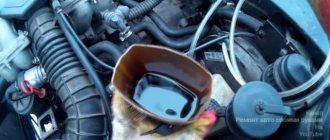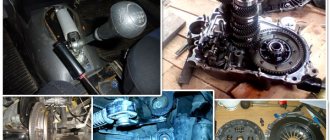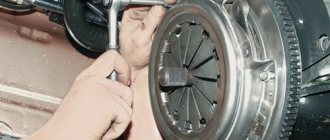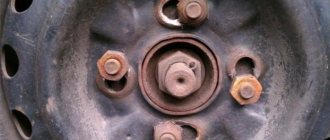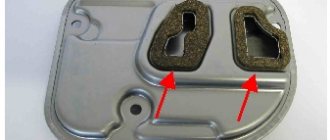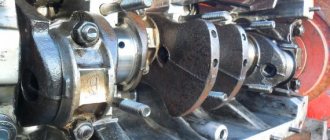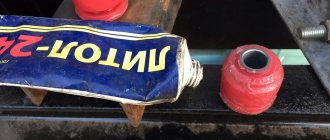Owners of cars with a manual transmission often encounter the problem of shifting gears, namely, after starting the internal combustion engine, one or more gears may not engage or engage, but with great effort. Also, when turning on the speeds, extraneous noise, vibrations, etc. may appear.
The problem may appear suddenly or progress gradually. Difficulties when switching gears can occur both on a “cold” and on a “warm” gearbox. In this case, the speed with the engine turned off will be switched on without much effort.
Next, we will look at why such malfunctions and failures occur, for what reason the gears do not engage when the engine is running, after replacing the clutch, first gear does not engage well, etc.
Reverse gear is difficult to engage
The transmission of cars makes it possible to change the engine torque and direct it to the drive wheels. It allows you to use the gearbox to change the speed of movement and maintain the engine in optimal mode. In addition, the checkpoint can direct the vehicle to move in the opposite direction. For this purpose, reverse speed is intended, which includes reverse movement. On different types of transmissions, a malfunction often occurs when reverse gear is difficult to engage. Let's consider the possible reasons for this behavior of the unit.
Why is reverse gear difficult to engage?
Regardless of what type of transmission is installed on the car (automatic or manual), poor engagement can be encountered at any gearbox. In such a situation, it is necessary to identify the breakdown and make repairs, since it is impossible to drive a car without reverse gear. Let's look at each reason in more detail.
Wear of the rocker bushing
Sometimes turning on reverse gear is accompanied by a lot of vibration and a characteristic crunch. The gear knob moves hard. In this case, the adjustment of the link, which connects the rod and the gear shift lever, may be disrupted. In addition, plastic bushings wear out quickly and must be replaced on time.
An experienced driver may notice excessive looseness and play in the lever. But if the wear occurs gradually, then it is difficult to notice the increasing free play. All repair work can be done directly from the salon. It is enough to remove the gear knob cover, remove the rocker and replace the bushing. After adjustment, the inclusions become clearer and softer.
The durability of a plastic part depends on the quality of the material used by the manufacturer. After adjusting the stroke of the rocker and replacing the bushing, this problem disappears. Sometimes craftsmen replace the factory mechanism with a shortened stroke. But they often forget that for it to work properly, it needs to be more accurately configured.
Electronics faults
Vehicles are equipped with different gearbox locking devices. Some vehicles use electromagnetic locking. In this case, the electrical wiring is located under the bottom of the car and is not protected by anything. In off-road conditions, the wires must be protected from damage, otherwise they will quickly become unusable. As a result, the supply of electricity to the interlock will stop and a problem will occur related to gear shifting.
Transmission traction is broken
Some cars are equipped with transmissions in which the shift rods are located outside the mechanism housing. In difficult climatic conditions (dirt, snow, icing), the free movement of traction is disrupted. This is especially noticeable when switching reverse gear, since it is rarely used. But in the morning it is necessary to leave the garage. To avoid such problems, in difficult conditions it is recommended to use a car that does not have external gear shift rods.
Note! Sometimes the length of the rod changes due to the loosening of the adjusting nuts, making shifting difficult. In this case, you will need to adjust and adjust the length, and the issue will be resolved.
There is not enough oil in the gearbox or its properties are reduced
If you do not take care of your car, a problem with engaging reverse gear may occur due to insufficient oil in the box or a deterioration in its performance properties. Inexperienced drivers believe that oil is poured into the gearbox all the time, and there is no need to change it. In reality, even high-quality lubricant with high mileage (about 100 thousand km) becomes unsuitable for use. These data correspond to a gentle driving mode.
But if the car is operated in difficult conditions associated with temperature changes, city traffic, and frequent switching, then the oil needs to be changed much more often. Over time, the properties of the lubricant change. Additives no longer work properly, harmful deposits, wear products, and dirt appear.
With dirty old oil, the gearbox mechanism works with difficulty not only when engaging reverse gear, but also other gears. It is necessary to pay attention to the presence of leaks under the car. If the lubricant leaks and its level is reduced, then the gearbox parts will wear out much faster than the period set by the factory.
Wear of release bearing, springs, gears, forks
Failure of the listed parts is accompanied by extraneous knocking or noise while driving, which is easy to hear. Reverse and other gears will be difficult to engage, or will become inaccessible altogether. To eliminate such malfunctions, you will need the help of specialists from a car repair shop. In this case, the gearbox will have to be removed from the car, so you should not start repairing this important unit yourself. This way you will save money and prevent further breakdowns.
Usually the fault is detected on the road: you stop at a traffic light, and when you try to shift into gear, difficulties arise. Cracks often appear on the shift fork, which even under light loads lead to the destruction of the entire part.
It happens that when starting off on loose snow or sand, the reverse gear switches off spontaneously. The handle has to be held forcibly.
The reasons may be the following:
Note! The driver can independently tighten the engine mounts and secure the rocker. To do this, the car will need to be installed on a pit or overpass.
Incomplete clutch disengagement
The gearbox and motor are connected by the clutch mechanism. When changing speed, the driver presses a special pedal to disconnect the gearbox from the engine. Then the desired gear is engaged and the clutch pedal is released. After this, torque is again transmitted to the wheels.
If the clutch is not completely disengaged when the speed is turned on, then reverse and other gears will be difficult to engage. This is further aggravated by the fact that on budget cars the rear and first gear gears are not equipped with synchronizers. Therefore, shifting problems due to a faulty clutch drive are most noticeable on them.
In such cases, when you engage reverse gear, you usually hear a metallic grinding and crunching sound in the gearbox. To eliminate the malfunction, you will have to remove the gearbox and check the condition of the clutch mechanism: disc, release bearing, basket. You will also need to adjust the drive and check the operation of the pedal.
That is, you first need to identify faults in the clutch control devices, and then remove the box and basket for troubleshooting and replacement of parts.
The cause of extraneous sounds in the clutch
We will consider only those cases in which improper operation of the clutch leads to extraneous sounds when switching and tight movement of the lever.
- Incorrect mechanical clutch adjustment. Over time, the cable stretches, causing the pedal travel to be insufficient to completely move the driven disc away from the flywheel. Adjusting the clutch release drive allows you to compensate for cable stretch and restore the working stroke of the clutch pressure plate.
- Play in the connections of the clutch release fork, rotary rod and release bearing.
- Breakage of one or several pressure damper springs. Fatigue of the metal “petals” also occurs. In this case, the springs lose their elasticity and do not provide the proper working amplitude for retracting the driven disk.
- Worn release bearing. If the release valve breaks, a characteristic rustling noise occurs only when the clutch pedal is depressed. The sound indicates dry friction of the bearing and the need to replace it.
- Air in the hydraulic circuit. The system must be ventilated after each intervention in the hydraulic drive, during which the system elements are disconnected.
- Malfunction of the clutch master or slave cylinder. Leaks in brake fluid compression result in insufficient pressure in the line. Because of this, the pushing force on the release bearing and, as a result, the amplitude of its movement decreases.
- Broken release bearing housing. This often happens with bearings in a plastic cage, which are partially destroyed under mechanical loads. In this case, the fork seat moves slightly relative to the bearing itself, which is why the amplitude of movement of the fork is not enough to completely disengage the clutch.
- Wedging of the input shaft needle bearing. It is installed in the flywheel and serves as one of the support points for the input shaft. In case of critical wear and increased friction between the rolling elements and the race, the primary bearing begins to jam. In this case, even after the clutch is completely disengaged, the torque from the flywheel will be partially transmitted to the input shaft. It is difficult to engage manual transmission gears due to jamming of the needle bearing, most often only at mileages over 400-600 thousand/km or due to a factory defect of the unit.
Why won't reverse gear engage in manual transmission? Among the most common reasons why reverse gear does not engage or is difficult to engage are the following: Incomplete disengagement of the clutch.
In other words, the gearbox is not disconnected from the engine. Clutch problems can make it difficult to engage all gears, but on some car models the problem is most noticeable when engaging reverse gear. Trying to change gear with the clutch not depressed enough is often accompanied by a crunching and loud grinding noise. Deformation of gearbox drive rods or levers. To exclude this item, it is necessary to conduct a thorough inspection of the transmission.
Damaged elements must be replaced. Loss of properties or insufficient level of transmission fluid.
We adjust the Daewoo Sens gearbox ourselves
Most drivers are confident that the oil in the gearbox has a lifespan equal to that of the car itself. Unfortunately, this is not the case: transmission fluid operates under difficult conditions and over time loses its performance properties or simply leaks out when the seal of the unit is broken.
Difficulty engaging first and reverse gears
These two speeds cause problems for drivers on most car models. The reverse gear does not engage well due to the fact that there is no synchronizer on its gear. They are installed only on higher-class cars, and they are not on budget cars. The first speed also often makes it difficult to drive a car, since it is used more often than others. Although a synchronizer is always installed on its gear.
More of these faults can be found on used cars. But even on new budget class models such breakdowns are not uncommon.
After replacing the clutch, reverse gears are difficult to engage
den1s_55
pull the cable
, but now I’m trying, I write messages during smoke breaks) There is no result yet, the 4th speed has become difficult to engage. the rest doesn't turn on!
Added after 18 minutes 20 seconds:
We adjusted that 3,4,5 turns on quite hard. 1,2 are not included. The disk was installed correctly 99%. What else could it be?
Well, then it could be: 1. The clutch was assembled crookedly and made of “shit”. 2. The transmission gear selection is crooked and not adjusted in any way. 3. Broken clutch fork. 4. The clutch drive is not CORRECTLY adjusted (that is, the cable). 5. Heavenly punishment.
Here's the question: did you do it yourself, or at the station? It’s just that if they are at the station, then there is a reason to spoil their brains. If you do it yourself. then why did you go there?
What sounds are there from under the gearbox and clutch? Or is it just stupid not to stick the gear in? And all the same, where is such confidence that the driven disk was not turned over then? Clutch pedal position in studio. How does the clutch fork move on the box, and does it move at all? There are no miracles, we changed 3 parts and the machine stopped working. Maybe the basket was bent into a hollow, or maybe it was not from the same car that was installed.
den1s_55
pull the cable
, but now I’m trying, I write messages during smoke breaks) There is no result yet, the 4th speed has become difficult to engage. the rest doesn't turn on!
Added after 18 minutes 20 seconds:
We adjusted that 3,4,5 turns on quite hard. 1,2 are not included. The disk was installed correctly 99%. What else could it be?
Well, then it could be: 1. The clutch was assembled crookedly and made of “shit”. 2. The transmission gear selection is crooked and not adjusted in any way. 3. Broken clutch fork. 4. The clutch drive is not CORRECTLY adjusted (that is, the cable). 5. Heavenly punishment.
Here's the question: did you do it yourself, or at the station? It’s just that if they are at the station, then there is a reason to spoil their brains. If you do it yourself. then why did you go there?
What sounds are there from under the gearbox and clutch? Or is it just stupid not to stick the gear in? And all the same, where is such confidence that the driven disk was not turned over then? Clutch pedal position in studio. How does the clutch fork move on the box, and does it move at all? There are no miracles, we changed 3 parts and the machine stopped working. Maybe the basket was bent into a hollow, or maybe it was not from the same car that was installed.
Source
Replacing clutch kit Chery A13 (Bonus)
Hello dear passengers of our VAGona!
Today I will tell you about my impressions when replacing the clutch on a Chinese car Chery A13, now called Chery Bonus. This masterpiece of the Chinese automobile industry arrived to us with a broken clutch, well, a replacement is just a replacement. At first glance, the car is like a car, in terms of interior, instruments and equipment, it was very reminiscent of a VAG car, only Chinese)))
The procedure is as usual, lift and unscrew everything? To remove the transmission, in this car, you definitely need to remove the subframe. Hm strange? but all reports indicate that axle shafts are removed from the gearbox, which leads to oil drainage. We decided not to engage in such perversions, everything can be taken out perfectly and come in half with the axle shafts.
The box is moved away and placed on stands. Actually, having moved the checkpoint, we saw such a picture, an oil painting, no, a gouache painting)))
Ok, we refer to our own crooked hands, we assemble according to the book, we made a mandrel, we centered the disk (for the first time, we centered it with our finger)))), we tightened everything momentarily. They threw on the box, assembled everything, and started it up. Fuck! They don’t turn on, they can’t be pressed! We used the old-time method, when there weren’t really any spare parts, and we riveted the clutches ourselves. We take washers 1mm thick, remove the starter, in the resulting window, clearly see the bolts for securing the clutch basket, put the washers.
Assemble - start - rejoice))) Everything switches))
Thank you for your attention!
PSss: Chery A13 does not have a clutch kit, only separately, a hardcore car! You buy it and pray that it fits!)))))
Source
Is it possible to put the clutch disc in reverse?
Comments 23
The same symptoms, but the fork has no play... Where to dig?
Good day. What's wrong with the clutch at the moment? According to the description my case. I replaced it with a Valeo 1000 km ago, now the pedal has become stiff, the gears are difficult to engage when hot. I raised the clutch pedal a centimeter - at first I was happy, I thought I had solved the problem, and then after 100 km. same crap. I raised it to the maximum, but my leg starts to get tired, and it’s not according to the manual, it’s too high, and still it sometimes crunches when it’s hot... There’s a characteristic underpressure along the way... Sometimes a double squeeze helps... What could be the reason?
When the speed of the car begins to turn on heavily, it not only causes an unpleasant feeling, but also makes the operation of the car unsafe. In this article we will analyze the reasons why gears are difficult to engage or do not shift at all, which is usually associated with this.
The gearbox is a complex mechanism that requires constant maintenance. Including regular diagnostics and gearbox oil changes. Ignoring these measures often leads to problems with gear shifting.
What are the reasons for poor gear shifting?
Difficulty shifting gears can occur as a result of improper operation of the gearbox, or due to operation of the vehicle on bad roads. Problems with the gearbox sooner or later occur in used cars.
If you have difficulties when trying to switch to another gear, you cannot shift or it takes a lot of effort, then there is clearly a malfunction. Most often, car owners turn to a car service center when they have difficulty engaging first gear or reverse gear . A fairly common problem on VAZ and Ford Focus cars.
Theory of gearbox operation
At the moment, all modern gearboxes are equipped with synchronizers, which are important elements of the gearbox. The essence of how synchronizers work is that they align the operation of the gearbox shafts.
Each driver, when moving from second to first, encountered a situation when he felt some kind of obstacle. What prevents you from engaging first gear when driving. This is a synchronizer.
If your transmission is new enough, you won't find yourself in this situation when shifting from high to low gear. The change will take place without problems. This occurs during operation and wear of the unit components.
If you have transmission problems, come to Ankar to diagnose and repair Mitsubishi, Toyota, Lexus, Land Rover, Jaguar, Infiniti, Mercedes, BMW, Audi and other brands.
Watch a video about the design and operating principle of the gearbox:
The owner installed a new clutch: the gears do not engage
So, the problem of gear shifting can arise due to serious malfunctions, such as: failure of synchronizers, wear or breakage of gears, jamming of gearbox components and mechanisms when selecting a gear. In this case, to identify breakdowns, it is necessary to dismantle the box with subsequent “defection” or replacement of damaged components.
If the breakdown is associated with a malfunction of the clutch, the failed elements are replaced, or the clutch is replaced with a new one. However, even after replacement, problems may occur.
The problem of shifting gears after replacing the clutch in full and incomplete sets
Drivers often encounter this problem: when a car owner has installed a new clutch, the gears do not engage. There may be several reasons for this. Let's look at each in more detail.
This element is located on the axis of rotation. Thanks to the clutch fork, the bearing moves together with the release clutch. The bearing disengages the clutch disc from engaging the basket (the clutch engages and disengages). There are two types of bearings:
When you press the clutch pedal on a car with the engine running, a characteristic knocking or noise appears. If the bearing is severely worn, it may jam and it will no longer perform its functions as a transmission device between the drive and the clutch.
The basket consists of: a pressure plate, a diaphragm spring and a casing. The clutch basket does not wear out as quickly as the clutch disc. If, after changing the clutch disc, the problem with gear shifting remains, you need to pay attention to the basket.
Often, basket malfunction is associated with wear of the petals (deformation, overheating, etc.). The basket ceases to perform its functions as it heats up, and as a result, the pressure disk is not completely retracted. The problem is solved by replacing the basket. If the problem is not corrected in time, then over time the release bearing and clutch disc may become damaged.
If the rear plane of the flywheel is damaged, it is reground on a machine in compliance with all standards. In cases where the flywheel crown is worn out, then it is replaced.
Troubleshooting methods
Once the source of the problem has been found, you can begin to eliminate the causes of the malfunction.
If the problem is in the engine
The simplest cause of problems when shifting gears can be a leak of brake fluid, which is the working fluid for the clutch. If there is insufficient lubrication in the clutch hydraulic system, it will not engage fully. Therefore, first check the fluid level in the car's tank. If the level is low, check for leaks, repair defects and bleed the clutch. When the fluid level is at the normal level, the clutch elements should be inspected.
Clutch problems
The clutch consists of three main components:
- disk;
- release bearing;
- baskets (pressure disk).
Malfunctions of these units can lead to problems with gear shifting when the engine is running.
The fact that the bearing is failing may be indicated by the appearance of a rustling or distinct hum when the engine is running and the clutch pedal is pressed to the floor. When you release the pedal, the noise should stop. When the bearing completely jams, it will no longer be possible to operate the gear shift mechanism. In this case, the unit will need to be replaced.
A faulty basket can also cause the problem. This often results from critical wear of the petals. In this case, the basket stops performing its functions when heated, and it is not possible to completely remove the pressure disk. Therefore, after removing the box, it is necessary to carefully inspect the basket for deformations and other defects. If the condition of the unit is not satisfactory, it should be replaced with a new one.
Finally, the last reason for problematic gear shifting associated with the clutch is wear or deformation of the disc and the friction linings on it.
Important! After the failed elements are replaced, during assembly you should center the box and also bleed the clutch
The problem is at the checkpoint
The most common cause of a gearbox malfunction is wear of the synchronizers. You may have previously been warned about this by a characteristic crunch when changing gears. Synchronizers that smooth out the angular speeds of the shafts are usually made of copper and are therefore subject to wear.
Much less often, the gearbox shafts themselves can fail. In this case, a separate transmission may not be included. The degree of wear and the need for replacement is also determined after dismantling and disassembling the transmission.
Important! To eliminate faults that have arisen in the box, a major overhaul may be required, which is not cheap and does not happen quickly. Therefore, you need to be prepared for the fact that your car will be delayed in service
However, you should not immediately think about the bad. Sometimes a problem with gear shifting can be caused by a lack of oil in the gearbox. Loud noise while driving or a metallic grinding sound in the box may indicate insufficient oil level. If there is a complete lack of oil, you will not be able to change gears at all: the synchronizers will not function properly. Changing the gearbox oil is recommended every 60-80 kilometers.
In addition to checking the oil level in the gearbox, you will also need to inspect the unit body for damage and the absence of lubricant leaks through the gaskets and seals.
Why is it difficult to engage manual transmission gears?
manual gear shifting
To prevent possible gearbox malfunctions, perform regular maintenance, change the oil on time, and in case of minor failures, rush for diagnostics . This will save you time and money in the future.
Watch the video for what not to do with a manual transmission:
What to do if it is difficult to engage reverse gear?
If you have difficulty engaging reverse gear, do one of the following :
How to properly engage reverse gear on a Hyundai Solaris, watch the video:
It's hard to engage first gear
Many drivers who encounter this situation try to force the gearbox selector to engage 1st speed. But this is fundamentally wrong and should not be done this way.
In this situation, it is necessary to use the regas method . Its essence is as follows:
However, this method should not be used on an ongoing basis when it is difficult to engage 1st gear. This method is temporary in order to at least get to the service station without any problems. In any case, the box will have to be repaired.
What to do when it’s hard to engage 1st gear on a car, watch the video from a driving instructor :
The procedure for replacing synchronizers requires experience, relevant knowledge and special tools, so it is better to contact professionals. Automotive technicians will perform the replacement quickly and efficiently, and will also advise you on further operation and maintenance of the box.
Lack of oil
When the problem lies in a lack of oil, the gears will still engage, and a metallic grinding sound will be felt. When there is not enough lubrication in the box, it is accordingly more difficult to make shifts. The gears simply cannot cling to each other. The same applies to the operation of synchronizers.
It is important that the oil in the box is at a sufficient level and that there are no leaks. If it is necessary to change the oil, it would be better to also replace the seals in the shank. It should be remembered that products from different manufacturers should not be mixed.
I changed the clutch: the gears do not engage after replacement
Owners of cars with a manual transmission often encounter the problem of shifting gears, namely, after starting the internal combustion engine, one or more gears may not engage or engage, but with great effort. Also, when turning on the speeds, extraneous noise, vibrations, etc. may appear.
The problem may appear suddenly or progress gradually. Difficulties when switching gears can occur both on a “cold” and on a “warm” gearbox. In this case, the speed with the engine turned off will be switched on without much effort.
Next, we will look at why such malfunctions and failures occur, for what reason the gears do not engage when the engine is running, after replacing the clutch, first gear does not engage well, etc.
Basket
If the gears are engaged with the engine running, but no grinding noise is heard. Most likely the problem is in the shopping cart. In this case, the clutch does not engage completely. In this case, many drivers prefer to completely replace the basket, but this is not always necessary. To clarify the reason, in any case, you will have to remove the box.
First you need to check the release bearing. It should move freely along the input shaft. If it is jammed or moves with difficulty in some places, this is the reason. A faulty bearing prevents the clutch from engaging completely. This problem is solved by replacing the problematic part.
Another reason is high disc wear. To determine its condition, it is necessary to disassemble the basket and assess its condition visually. There should be no visible rivets on the friction linings, and there should be no carbon deposits on them. If there is at least one of these signs, then you should install a new disk. Most likely, the problem with shifting gears will be solved.
It is somewhat more difficult to determine if the basket is faulty. Over time, the level of wear on the petals becomes prohibitive. As a result, they become susceptible to high temperatures. Once heated, such a basket cannot completely retract the pressure disk.
In some cases, it is enough to visually look at the basket. The petals will be slightly bent and will show signs of overheating or damage. Another diagnostic method, available in any garage, is to install a known working part on the car. If the car started to work as it should, the reason was in the basket.
Hydraulic booster. In this case, the problem may appear periodically. Most often on the move. This is due to a lack of fluid in the system and/or the presence of air there. This can be determined visually by simply looking into the tank. If a fluid leak is detected, all drive components should be checked. Be sure to inspect the tubes, hoses, and release cylinder. All identified leaks are eliminated. After which you should bleed the system.
Problems with automatic shifting
An automatic transmission is very demanding in maintaining the oil level and its condition, unlike a manual transmission. Too high or low oil level can lead to machine malfunction. In addition, due to a lack or excess of oil, difficulties may arise in switching gears.
The most common automatic transmission faults:
The oil level in the automatic transmission is checked using a dipstick. If the oil level is low, add.
What's the result?
As you can see, if such a problem arose when the owner replaced the clutch and the gears do not engage, it is necessary to determine the cause. First of all, you shouldn’t immediately rush to change the clutch again.
The fact is that there are many reasons why the gears do not turn on or are not turned on completely. In any case, to identify faults, it is first necessary to conduct a complete diagnosis of the gearbox. As part of the checks, it is necessary to separately take into account which clutch elements were changed, whether adjustments were made, adjustments to the rocker, etc.
Communities › Mitsubishi Lancer Club › Blog › Trouble with clutch It’s hard to engage gears
koyo release What mileage does the car have?
There may be severe wear on the guide sleeve along which the release bearing moves when the pedal is pressed. Change the clutch! Buy the “Exedy MBK2106” kit (if Lancer9 and 1.6i engine) before replacing and see how the rear gearbox mount is doing. Just changing it separately will break your hands, otherwise you can combine it with the clutch) Take only the original pillow, the other one won’t work and you’ll climb again!
It feels like the clutch fork has burst and started to bend.
a clearly expressed feeling that the clutch is not pressing. And when the clutch disappeared, what absurdities happened to it?
The owner installed a new clutch: the gears do not engage
So, the problem of gear shifting can arise due to serious malfunctions, such as: failure of synchronizers, wear or breakage of gears, jamming of gearbox components and mechanisms when selecting a gear. In this case, to identify breakdowns, it is necessary to dismantle the box with subsequent “defection” or replacement of damaged components.
If the breakdown is associated with a malfunction of the clutch, the failed elements are replaced, or the clutch is replaced with a new one. However, even after replacement, problems may occur.
The problem of shifting gears after replacing the clutch in full and incomplete sets
Drivers often encounter this problem: when a car owner has installed a new clutch, the gears do not engage. There may be several reasons for this. Let's look at each in more detail.
Finding the reason
The easiest way to determine why manual transmission gears do not engage is in two ways:
1. Stop the engine and turn up the speed - If nothing happens, then the problem is most likely due to faulty synchronizers or gears. To determine the culprit of the breakdown, the manual transmission will have to be disassembled.
2. Start the engine and put the car in gear - If it doesn't work, the problem is in the clutch. Most often, this malfunction is caused by problems such as insufficient lubrication, incomplete engagement of the clutch and lack of fluid in the drive hydraulic system. Moreover, the last malfunction is typical only for cars equipped with a hydraulic clutch.
In any case, in order to determine the true cause, you will have to remove the manual transmission and inspect the condition in which the clutch basket is located; if it is satisfactory, check the volume of fluid that is in the expansion tank and if it is insufficient, top up.
Methodology for driving a vehicle
When you engage reverse, too.
The forward-backward handle is on the right under the chair; backrest tilt handle - left; • put the lever in neutral (if you don’t check it, you can drive right after turning the key, unexpectedly); • you can release the clutch pedal (or you can [but not necessarily] not release it to make the starter’s work easier); • turn the key 180° clockwise: in this position, current flows to the spark plugs, and ignition occurs when the engine is running; • key - to the starter, that is, turn it another 45° clockwise (hold for no more than 2 seconds)
It is difficult to engage first gear when the clutch is depressed
help me figure out what's wrong?
The car sat for a very long time, changed clothes and started, but did not make a trip.
Have you checked the oil in the box? If yes, then try rocking with the clutch depressed (if the sound does not change, then the clutch is not disconnecting the engine and gearbox). Maybe someone else can tell me something or remove the box and look at the clutch.
By the way, the Kraft clutch lasts a long time and how is the quality? By the way, the Kraft clutch lasts a long time and how is the quality? It's better to engage 4th gear. My clutch disc is AT.
It's been 1.5 years (45 thousand km), I removed the gearbox and the clutch disc is normal.
But clutch wear is 50% dependent on the driver. Acceleration and braking are strong! All this with the clutch pedal depressed.
After half an hour, it was decided to change the clutch) What's the point of driving the car with the gear engaged and the clutch depressed? So you can drive in neutral. The task was, as far as I understand, to tear off the driving clutch disc from the driven one.
In neutral, the clutch disc has the same speed as the engine's CV. The same thing happens when the speed is on and the clutch is released.
During normal operation of the gearbox and clutch, synchronizers contribute to the inclusion of speeds.
How to check if the clutch is slipping?
There are three methods for checking whether the clutch is slipping on a manual transmission. Its operation is well controlled by the driver. But there are no effective methods for a robot or a variator. Their automation can partially mask the symptoms of the problem, so the techniques that are relevant to mechanics do not always work. How to determine that the clutch is slipping on different types of gearboxes is described in more detail below.
Clutch slips on manual transmission: how to determine?
The main reason why the clutch slips when the friction linings wear out is a decrease in the pressing force between the discs due to a decrease in their thickness. There are 3 main ways to check whether the manual transmission clutch is slipping:
- Start from high gear . To check whether the clutch is slipping on a manual transmission, you need to engage 4th or 5th gear and try to move off. If the engine stalls, everything is fine. If, even at relatively low (up to 3000 rpm) revolutions, the car starts to move, the disc slipping is obvious.
- Handbrake test . For this test, you need to lock the car's wheels with the parking brake and try to start in first gear. If the engine stalls or (on front-wheel drive) the wheel slips, then everything is fine. If the wheels are stationary, but the engine continues to work in gear, it means the clutch has begun to slip.
- Hard acceleration test . To do this check, you need to engage the highest (4th, 5th, 6th) gear while driving and give the gas sharply. If the car picks up speed synchronously with the increase in revolutions on the tachometer, there are no problems. If the revolutions fluctuate, they sharply increase without acceleration (the so-called variator effect) - obviously, the clutch or disc is slipping.
Before checking whether the new clutch is slipping or not, you need to make sure that the unit is assembled and configured correctly. Sometimes, if the reason is only insufficient running-in of new spare parts to each other, the symptoms of slipping themselves go away after a few hundred kilometers of driving.
How to diagnose whether the clutch is slipping on a robot?
To understand whether the “robot” clutch is slipping or not, you can put the box in manual mode, engage the highest gear and give the gas to the floor, but this does not always help. The same applies to starting with the handbrake.
The most effective way to determine clutch wear on a robotic gearbox is to connect to the ECU using an OBD-2 scanner and read the errors using a diagnostic application. Transmission-related faults are indicated by codes P07xx to P09xx, and excessive clutch slip is indicated by code P0811
Deciphering error P0811
Modern manual transmissions, such as DSG for VAG, Speedshift for Mercedes, DCT for BMW and other similar designs, are equipped with a double clutch. The latest generations use a self-supplying wet clutch, which does not require adjustment, as it automatically adjusts the gaps as it wears out. Older and simpler “robots” (such as the 2182 gearbox on a VAZ) have a conventional dry single-plate clutch.
Determining that a self-actuating clutch is slipping is most difficult, since the automatic system smoothes out the manifestations. Excessive clearance is eliminated by a self-feeding mechanism. Therefore, in this case, problems with adjustment can be eliminated. But if the clutch of a DSG 7 or similar manual transmission slips, you need to immediately check the oil in it, and only then do tests.
The clutch slips on an automatic transmission: what to do?
In classic torque converter automatic transmissions, the torque converter (“donut”) is responsible for transmitting torque from the engine to the box, so the question of what to do if the clutch slips is not worth it in this case. If it seems to you that the clutch is slipping on the machine, it is usually due to a malfunction of other components:
- Automatic transmission clutches slip . The clutches are a mini version of a wet multi-plate clutch, separate for each gear. It is when they wear out that it seems that the clutch on the automatic transmission has begun to slip, because the symptoms are similar: the speed fluctuates, the car accelerates sluggishly, and jerks occur in movement.
- The torque converter fails . A worn-out “donut”, which plays the role of the main clutch, can also slip. If the car sluggishly picks up speed, the engine begins to constantly maintain higher speeds (although the load has not increased), fuel consumption has increased - the torque converter is worn out.
If you experience symptoms of a slipping clutch on an automatic transmission, you need to diagnose the box. Errors (codes from P07xx to P09xx) read via OBD-2 will help you find out the general cause, and only troubleshooting at a car service will show the specific degree of the malfunction.
The clutch on the variator is slipping: how to determine and what to do?
If the clutch on a variator slips, it is difficult to identify the defect and the cause without diagnostics. You need to read the errors and, if you have the appropriate codes, go to the service center for detailed troubleshooting and repair. This feature is related to the operating principle of CVT gearboxes.
Diagnostics of the variator using the CVTz50 program
Continuously variable transmissions can be equipped with either a clutch or a torque converter. Multitronic gearboxes on Audi and Multimatic on Hondas are equipped with a wet clutch, Hyper on Nissans has an electromagnetic clutch, and ZF Transamtic CVTs are equipped with an automatic centrifugal clutch. These mechanisms are capable of slipping, just like with a manual one, but the variator masks the symptoms as much as possible.


